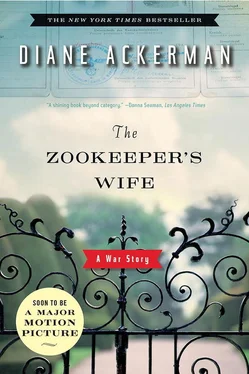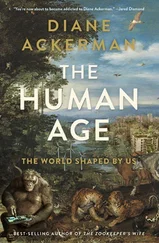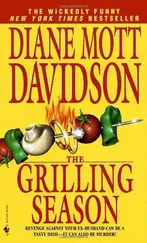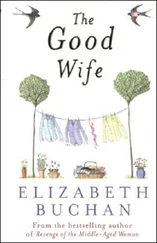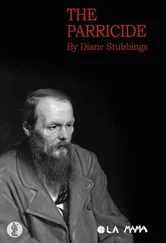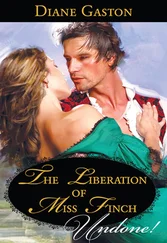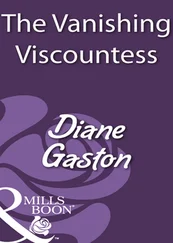Diane Ackerman
THE ZOOKEEPER’S WIFE
A WAR STORY
For Antonina
and her family,
human and animal
JAN AND ANTONINA ŻABIŃSKI WERE CHRISTIAN ZOOKEEPERS horrified by Nazi racism, who capitalized on the Nazis’ obsession with rare animals in order to save over three hundred doomed people. Their story has fallen between the seams of history, as radically compassionate acts sometimes do. But in wartime Poland, when even handing a thirsty Jew a cup of water was punishable by death, their heroism stands out as all the more startling.
In telling their story, I’ve relied on many sources detailed in the bibliography, but most of all on the memoirs (“based on my diary and loose notes”) of “the zookeeper’s wife,” Antonina Żabíńska, rich with the sensuous spell of the zoo; her autobiographical children’s books, such as Life at the Zoo; Jan Żabiński’s books and recollections; and the interviews Antonina and Jan gave to Polish, Hebrew, and Yiddish newspapers. Whenever I say Antonina or Jan thought, wondered, felt, I’m quoting from their writings or interviews. I’ve also depended on family photographs (that’s how I know Jan wore his watch on his hairy left wrist and Antonina had a thing for polka-dot dresses); conversations with their son Ryszard, various people at the Warsaw Zoo, and Warsaw women who were contemporaries of Antonina and also served the Underground; writings by Lutz Heck; artifacts viewed in museums, such as the dramatic Warsaw Uprising Museum and the eloquent Holocaust Museum in Washington, D.C.; the State Zoological Museum archives; the memoirs and letters collected by a secret group of wartime archivists who hid (in boxes and milk churns) documents that now reside at the Jewish Historical Institute in Warsaw; testimonies given to Israel’s unique Righteous Among Nations program and the superb Shoah Project; and letters, diaries, sermons, memoirs, articles, and other writings by citizens of the Warsaw Ghetto. I studied how Nazism hoped, not only to dominate nations and ideologies, but to alter the world’s ecosystems by extinguishing some countries’ native species of plants and animals (including human beings), while going to great lengths to protect other endangered animals and habitats, and even to resurrect extinct species like the wild cow and forest bison. I pored over guides to Polish wildlife and plants (exploring Poland’s natural world provided a steady stream of small astonishments); guides to Polish customs, cuisine, and folklore; and books on Nazi drugs, scientists, weapons, and other themes. I relished learning about Hasidism, Kabbalah, and pagan mysticism of the early twentieth century; Nazism’s roots in the occult; and such practical matters as Polish social and political history and Baltic lampshades of the era.
I’m also indebted to the knowledge of my invaluable Polish advisor, Magda Day, who spent her first twenty-six years in Warsaw, and her daughter, Agata M. Okulicz-Kozaryn. On a trip to Poland, I gathered impressions at Białowieża Forest and in the Warsaw Zoo itself, where I loafed and prowled around the old villa and retraced Antonina’s steps on the surrounding streets. I’m especially grateful to Dr. Maciej Rembiszewski, the current director of the Warsaw Zoo, and his wife, Ewa Zabonikowska, for their generosity of time and spirit, and also to the zoo staff for their knowledge, resources, and welcome. My thanks also go to Elizabeth Butler for her tireless and always upbeat assistance, and to Professor Robert Jan van Pelt for his careful critique.
I came to this story, as to all of my books, by a very personal route: Both of my maternal grandparents came from Poland. I’ve been intimately influenced by accounts of Polish daily life from my grandfather, who grew up in Letnia, a suburb of Przemyśł, and left before World War II, and from my mother, some of whose relatives and friends lived in hiding or in the camps. My grandfather, who lived on a small farm, shared folk stories passed down through generations.
One of them tells of a village with a little circus whose lion had suddenly died. The circus director asked a poor old Jewish man if he would pretend to be the lion, and the man agreed since he needed the money. The director said: “All you have to do is wear the lion’s fur and sit in the cage, and people will believe you’re a lion.” And so the man did, muttering to himself, “What strange jobs I’ve had in my life,” when his thoughts were interrupted by a noise. He turned just in time to see another lion creeping into his cage and fixing him with a hungry stare. Trembling, cowering, not knowing how to save himself, the man did the only thing he could think of—vociferously chant a Hebrew prayer. No sooner had he uttered the first desperate words, Shema Yisroel (Hear O Israel)… than the other lion joined in with adonai elohenu (the Lord our God), and the two would-be lions finished the prayer together. I could not have imagined how oddly relevant that folk story would be to this historical one.
SUMMER, 1935
AT DAWN IN AN OUTLYING DISTRICT OF WARSAW, SUNLIGHT swarmed around the trunks of blooming linden trees and crept up the white walls of a 1930s stucco and glass villa where the zoo director and his wife slept in a bed crafted from white birch, a pale wood used in canoes, tongue depressors, and Windsor chairs. On their left, two tall windows crowned a sill wide enough for sitting, with a small radiator tucked below. Oriental rugs warmed the parquet floor, where strips of wood slanted together as repeating feathers, and a birch armchair squared one corner of the room.
When a breeze lifted the voile curtain enough for grainy light to spill in without casting shadows, barely visible objects began anchoring Antonina to the sensible world. Soon the gibbons would start whooping, and after that a pandemonium rip no one could sleep through, not owl-eyed student or newborn. Certainly not the zookeeper’s wife. All the usual domestic chores awaited her each day, and she was clever with food, paintbrush, or needle. But she also had zoo problems of her own to solve, sometimes uncanny ones (such as hyena-cub soothing) that challenged her schooling and native gifts.
Her husband, Jan Żabiński, usually arose earlier, dressed in trousers and a long-sleeved shirt, and slid a large watch over his hairy left wrist before padding downstairs. Tall and slender, with a strong nose, dark eyes, and the muscular shoulders of a laborer, he was built a little like her father, Antoni Erdman, a Polish railroad engineer based in St. Petersburg, who traveled throughout Russia following his trade. Like Jan, Antonina’s father had plenty of mental muscle, enough to get him and her mother, Maria, shot as members of the intelligentsia in the early days of the Russian Revolution in 1917, when Antonina was only nine. And like her father, Jan was a kind of engineer, though the connections he fostered were between people and animals, and also between people and their animal nature.
Balding, with a crown of dark brown hair, Jan needed a hat to fight burn in summer and chill in winter, which is why in outdoor photographs he’s usually wearing a fedora, giving him an air of sober purpose. Some indoor photographs capture him at his desk or in a radio studio, jaw tight in concentration, looking like a man easily piqued. Even when he was clean-shaven, a five o’clock shadow stippled his face, especially on the philtrum between nose and mouth. A full, neatly edged upper lip displayed the perfect peaks women create with lip liner, a “Cupid’s bow” mouth; it was his only feminine feature.
Читать дальше
